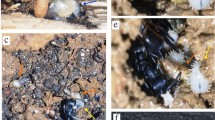Summary
Myrmecophytic Piper spp. were re-examined in view of what has become a common expectation in studies of mutualistic ant-plant associations: overtly aggressive behavioral traits in ants that function in anti-herbivore defense. Piper plants provide food and shelter for the Pheidole ant inhabitants. The ants, small and “sluggish”, were previously thought to serve in nutrient procurement for the plant even though their foraging is probably restricted to the plant surface and most of the ants' food is produced by the plant itself.
An alternative hypothesis, that Pheidole ants function in anti-herbivore defense by disrupting herbivores as eggs or early instars occurring on Piper foliage, was tested using the following lines of reasoning: (1) If the youngest, tender leaves are more vulnerable to herbivore attack, or simply more valuable to the plant, then ants may “patrol” these leaves preferentially. More ants were found on young leaves (\(\bar X\)=2.00 ants/leaf) than on mature leaves (\(\bar X\)=0.51). (2) If the ants are functioning in anti-herbivore defense, herbivory should be lower on occupied plants than on plants without ants. Estimates of mean percent foliovore damage per sapling showed that for samples with similar average heights (and presumably, ages), the unoccupied plants had significantly greater damage. A comparison of newest leaves showed a significant trend for damage to decrease with increased ant activity. (3) If ants are attacking hervibores at early stages of development, baiting with eggs should demonstrate this activity. Over 75% of all egg baits on young and mature leaves were taken up by an ant during observation periods of 30 or 60 min. Baits were found significantly faster on young than on mature leaves. In over half of the baiting trials, the egg was taken to the edge of the leaf and dropped to the ground rather than sequestered as a nutrient source.
These data suggest that Pheidole inhabiting Piper plants are important in plant defense from herbivores and that adherance to a classical notion of aggression in similar studies might bias the initial question-asking stages of an investigation.
Similar content being viewed by others
References
Belt T (1874) The naturalist in Nicaragua. Murray, London
Bentley BL (1976) Plants bearing extrafloral nectaries and the associated ant community: Interhabitat differences in the reduction of herbivore damage. Ecology 57:815–820
Bentley BL (1977a) Extrafloral nectaries and protection by pugnacious bodyguards. Ann Rev Ecol Syst 8:407–427
Bentley BL (1977b) The protective function of ants visiting the extrafloral nectaries of Bixa orellana L. (Bixaceae). Ecology 65:27–38
Carroll CR, Janzen DH (1973) Ecology of foraging by ants. Ann Rev Ecol Syst 4:231–257
Deuth D (1977) The function of extra-floral nectaries in Aphelandra deppeana Schl. & Cham. (Acanthaceae). Brenesia 10/11:135–145
Heithaus ER, Culver DC, Beattie AJ (1980) Models of some antplant mutualisms. Am Nat 116:347–361
Holdridge LR (1964) Life Zone Ecology. Tropical Science Center, San José, Costa Rica
Huxley CR (1978) The ant-plants Myrmecodia and Hydnophytum (Rubiaceae), and the relationships between their morphology, ant occupants, physiology and ecology. New Phytol 80:231–268
Inouye DW, Taylor OR (1979) A temperate region plant-ant-seed predator system: consequences of extra floral nectar secretion by Helianthella quinquenervis. Ecology 60:1–7
Janzen DH (1966) Mutualism between ants and acacia in Central America. Evolution 20:249–275
Janzen DH (1967) Interaction of the bull's-horn acacia (Acacia cornigera) with an ant inhabitant (Pseudomyrmex ferruginea) in eastern Mexico. Kans Univ Sci Bull 47:315–558
Janzen DH (1972) Protection of Barteria (Passifloraceae) by Pachysima ants (Pseudomyrmecinae) in a Nigerian rain forest. Ecology 53:885–892
Janzen DH (1973) Dissolution of mutualism between Cecropia and its Azteca ants. Biotropica 5:15–28
Janzen DH (1974) Epiphytic myrmecophytes in Sarawak: mutualism through the feeding of plants by ants. Biotropica 6:237–259
Keeler KH (1980) The extrafloral nectaries of Ipomoea leptophylla (Convolvulaceae). Am J Bot 66:1016–1020
Keeler KH (1981) A model of selection for facultative nonsymbiotic mutualism. Am Nat 118:488–498
Lehmann EL (1975) Nonparametrics: Statistical Methods Based on Ranks. Holden-Day, Inc.: San Francisco
Montagu MFA (1968) (Ed.) Man and Aggression. Oxford University Press: New York
Müller F (1876) Fritz Müller on Brazil Kitchen middens, Habits of ants, etc. Nature 13:304–305
Risch S, McClure M, Vandermeer J, Waltz S (1977) Mutualism between three species of tropical Piper (Piperaceae) and their ant inhabitants. Am Midl Nat 98:433–444
Risch SJ, Rickson FR (1981) Mutualism in which ants must be present before plants produce food bodies. Nature 291:149–150
Seigler D, Saupe SG, Young DA, Richardson PM (1982) Acacia rigidula — a new ant-acacia. Southwestern Naturalist 27:364–365
Sokal RR, Rohlf FJ (1969) Biometry. W.H. Freeman and Co.: San Francisco
Wheeler WM (1910) Ants: their structure, development, and behavior. Columbia University Press: New York
Author information
Authors and Affiliations
Rights and permissions
About this article
Cite this article
Letourneau, D.K. Passive aggression: An alternative hypothesis for the Piper-Pheidole association. Oecologia 60, 122–126 (1983). https://doi.org/10.1007/BF00379331
Received:
Issue Date:
DOI: https://doi.org/10.1007/BF00379331




